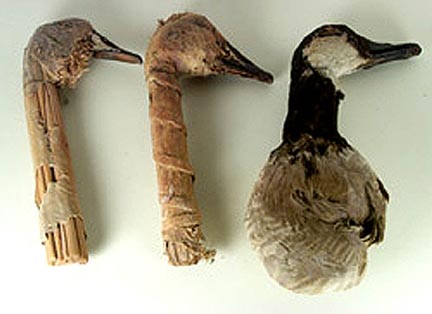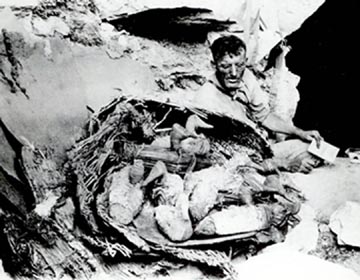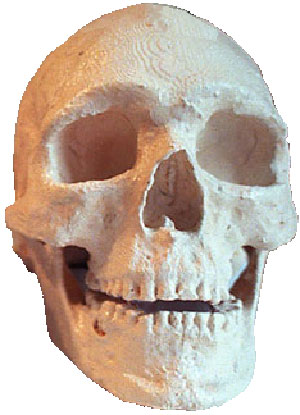| Online: | |
| Visits: | |
| Stories: |

| Story Views | |
| Now: | |
| Last Hour: | |
| Last 24 Hours: | |
| Total: | |
Proof Of the Actual Ancient Americans
Nevada had many ancient finds of human remains that do not fit the norm (see my post on the slope-headed skull.) Here are two of numerous notable finds that did not jive with recognized types of peoples of the United States; Spirit Cave and Lovelock Cave (and there are others in Nevada including Wizard's Beach mummy that no one speaks of much).
You may draw your own conclusions about government agencies and their hand in keeping us in the dark. It would appear from many anthropologist and archaeologist's commentary that they are well aware of this other “out of place/out of time” skull type that is not in any way related to Amerind people and pre-dates their arrival to the Americas and specific regions of the United States.
Source: In 1994, the Nevada State Museum radiocarbon dated a burial recovered in 1940 from Spirit Cave, near Fallon. To everyone’s surprise, “Spirit Cave man” lived over 9,400 years ago. He was over 40 years old, elderly for any culture in the world at that time. He wore a rabbit skin robe and fur moccasins. Very sophisticated, labor-intensive basketry accompanied his burial.
Note from blog author: The newest information I could get, the remains will be given to the Paiutes to bury which is a total abomination in my opinion because these are not the remains of their people! We need to change the rules henceforth that ancient finds must be tested to prove DNA connection before being handed over to Native People. We cannot assume tribe or even relationship in classification of human type. Basic logic: If I moved onto someone's property and they were dug up on the land, no one should assume we were related.
- hair, 9,360 +/- 60 (CAMS 12354)
- hair, 9,350 +/- 70 (CAMS 12353)
- hair, 9,440 +/- 60 (CAMS 14224)
- bone, 9,430 +/- 60 (CAMS 12352)
- twined tule mat, 9,410 +/- 60 (CAMS 24192)
- twined tule mat, 9,460 +/- 60 (CAMS 24197)
- diamond-plaited mat, 9,430 +/- 70 (CAMS 24199)
- Burial 1 (above mummy), ***9,270 +/- 60 (UCR 3480)
- twined hemp bag, Cremation 2, 9,040 +/- 50 (UCR 3478)
Lovelock Cave
***Source: Scholars suggest that the Southern Paiutes and other Numic speaking peoples began moving into the Great Basin and Colorado Plateau around 1000 A.D.***
Interestingly, Lovelock Cave duck decoys found with the mummies, dated to around 2200 years ago- putting them around 200 BCE (Before Common Era or BC) and LONG before the 1000 AD date of the Paiutes arrival.
That doesn't sound like the Paiutes could possibly lay claim to either the tule weaving duck decoys or the bodies of those red-haired mummies uncovered there. They hadn't even arrived there yet!
Source: As an interesting aside, in Virginia a couple very recently found the oldest yet stand of stone circles in America dating 10,000 years ago (twice as old as Stonehenge). Interestingly, nearby 12,000 year old carved handprints in the rock were made by what they refer to loosely as Paleo-Indians. Virginia reports that it has had people there since around 12,000 years ago, but with all of this being prehistoric, there is no way of telling if any of those people 12,000 years ago were today's Native Americans or the “first migration” people.
First, there must be recognition of these other technologically advanced people and then division of what was these ancient people's work and what was Amerind people adopting what they learned from this advanced culture (as did primitive humans around the world).
We will never get the true history of the Americas (or even the entire world) until someone steps forward and admits this “oopart” (out of place/out of time artifacts) issue and that there is strong evidence of not-related-to-Mongoloid people earlier inhabitants.
This should not in any way belittle man's advancement. It is obvious we won out and took the base knowledge our predecessors gave us to take it a step further. But, it is vital we understand how man did things that seemed “out of place/out of time” and quit attributing it to either aliens or our early homo sapiens wandering into the Americas and suddenly becoming knowledgeable way ahead of their time. We cannot understand the people we refer to as “Natives” if we don't understand their true contributions and genuine culture of their own ancestors. There might even come a bigger understanding of the influences of techniques, spirituality, and much more if the “Native People” understand their ancestors' exposures and true technology.
For example, my father helps me learn how to read faster than if I tried to learn on my own, but once I read, I consume many books and begin to write books. None of this would have happened in my short lifetime if he had not started me off early with the skills and his knowledge for me to take it even further, but I can neither take credit for my father's knowledge of reading or the books that were here before I learned to read, only that I took the concepts and ran.
The same goes for people all over the world who are acculturating the remains of ancient people and their architecture and credit for technology that were not their own.
The most ancient petroglyphs in America were found in Nevada. And, who carved them? Should we give local tribes the credit? Well, let's have a look –
Glyphs: (“National Geographic” link) The carbonate ages, combined with an analysis of sediment cores taken from neighboring Pyramid Lake, suggest that the boulders were exposed to air—and thus accessible for carving by humans—between about 14,800 to 13,100 years ago, and again from about 11,300 to 10,500 years ago. In between the two time periods, the boulders were submerged, the scientists say. Scientists say they have found genetic evidence that a first wave of migrants (*interestingly chosen term “migrants”) crossed into the Americas from Asia about 15,000 to 18,000 years ago by slowly creeping down the continent's coasts. A few thousand years later, according to the study, a second wave of humans (*now they differentiate with the term “humans”) entered North America, this time by slipping across the Bering Strait into Alaska and then crossing through an ice-free corridor into Canada.
Evidence repeatedly stacks up and there is an issue between the Federal government's mandate that local tribes be allowed all prehistoric remains found and the few truly earnest researchers who really want the answers. This is akin to forcing archaeologists to hand over ancient remains in Egypt to the people living there now to rebury. I do not understand this logic and there is a definite fear for anyone to come forward and say, guess what, Native Americans were not the first residents of the Americas. There is nothing wrong in that. Most land has been inhabited in the past by another race of man.
We all are “second migration, third, perhaps tenth!”
Source: http://www.ghosthuntingtheories.com/2014/05/proof-of-actual-ancient-americans.html






